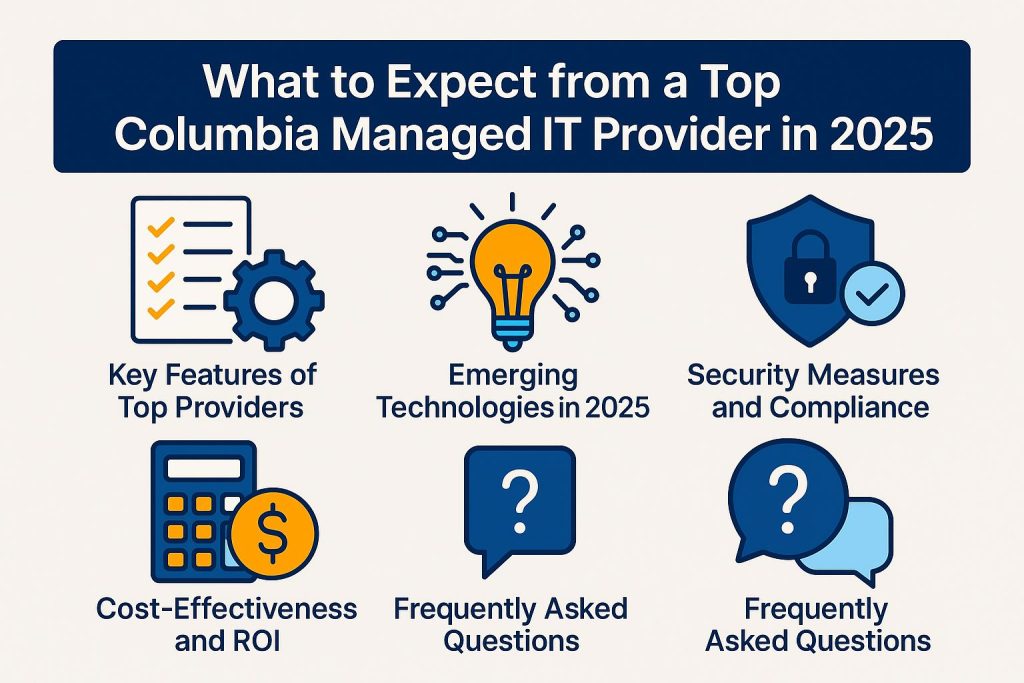Preparing Your Columbia SC Business for IT Technology Changes: Adaptation Strategies for 2025

Staying ahead of IT technology changes for Columbia SC businesses is vital for long-term success. As industries evolve, organizations must adopt proactive adaptation strategies to remain competitive in 2025 and beyond.
This article explores current and future IT trends, infrastructure assessments, and practical steps to guide your business through digital transformation.
Explore our IT Strategy and Planning Services to support your technology roadmap.
Understanding IT Technology Changes

Understanding IT technology changes is crucial for businesses. This is especially true in Columbia, SC, as digital transformation reshapes industries.
The rapid pace of technological change, fueled by emerging technologies such as artificial intelligence, cloud computing, and data analytics, requires organizations to develop effective adaptation strategies to maintain competitiveness.
As 2025 nears, businesses must proactively embrace these changes. They face challenges in ensuring continuity and optimizing efficiency.
Overview of Current and Future Trends
Current and future IT trends show a landscape with innovations in cloud services, cybersecurity, and data management. These are vital for operational excellence.
As remote work continues to gain momentum, organizations are compelled to reevaluate their IT infrastructures to ensure seamless connectivity and collaboration among employees, regardless of their locations. This shift emphasizes the critical need for robust cybersecurity measures to safeguard sensitive data against emerging threats.
Additionally, integrating digital tools is essential for streamlining processes. It enhances efficiency and fosters innovation. Investing in technology not only enables organizations to remain competitive but also plays a crucial role in developing a proactive IT strategy that aligns with their overarching business objectives.
By embracing these emerging trends, local businesses will be better equipped to navigate the challenges presented by an increasingly dynamic digital landscape.
Adapting Your Business for IT Technology Changes
Adapting to IT technology changes requires a strategic approach. This includes assessing current infrastructure and implementing change management practices.
In Columbia, SC, businesses must acknowledge the vital importance of IT consulting in identifying gaps and opportunities within their technology stack, particularly as digital transformation trends evolve.
Adopting agile methods and promoting innovation helps companies build a resilient framework. It supports continuous adaptation to market changes.
Assessing Your Current IT Infrastructure
Assessing current IT infrastructure is critical. It helps organizations understand their readiness for rapid changes in IT technology, particularly in areas such as data management and cybersecurity.
To effectively evaluate the existing setup, organizations should conduct comprehensive technology assessments that extend beyond superficial reviews. This process involves analyzing performance metrics such as system uptime, data processing speeds, and user satisfaction rates, ensuring that these elements align with broader business objectives.
By closely examining these factors, decision-makers can identify their IT strengths—such as robust security protocols or flexible cloud solutions—and weaknesses, including outdated hardware or insufficient bandwidth.
Recognizing these components is essential. It informs future technology investments and enables organizations to adapt strategies that enhance efficiency and foster growth.
Developing an Adaptation Strategy

Create a flexible adaptation strategy. This helps transition to new IT technologies. It ensures change readiness and a clear technology roadmap for businesses in Columbia, SC.
This strategy should align technology investments with business objectives. This can enhance efficiency and drive growth.
Fostering digital literacy among employees is crucial. It enables them to use new tools effectively. For example, a local firm might implement collaboration platforms such as Microsoft Teams or Slack to facilitate seamless communication and project management.
Embracing agile practices helps organizations adapt to market demands. These practices include iterative development and regular feedback. Companies that commit to continuous improvement and actively engage employees in this process often find themselves at a competitive advantage.
Implementing Changes and Managing Risks
Implementing changes in IT while managing risks is essential. This helps businesses maintain a competitive advantage in a changing technological landscape.
In Columbia, SC, organizations must prioritize the establishment of robust IT support systems and proactive change management strategies to facilitate seamless transitions.
As companies adopt automation and digital tools, they must also address potential risks related to cybersecurity and data privacy, ensuring comprehensive business resilience and compliance with industry standards.
Ensuring Smooth Transition and Integration
A smooth transition to new IT technologies requires a clear plan. This plan should consider the existing technology and user experience, addressing technical and organizational challenges.
To achieve effective system integration, it is essential to implement best practices that encompass IT governance, robust user training, and meticulous vendor management.
IT governance plays a critical role by establishing clear protocols and guidelines, ensuring that all stakeholders are aligned with the organization’s strategic goals. Concurrently, providing comprehensive user training fosters confidence and proficiency, enabling employees to adapt seamlessly to the new systems.
Vendor management is also crucial, as selecting reliable partners can enhance the integration process and mitigate potential risks. Maintaining a continuous focus on user experience throughout this journey not only improves satisfaction but also drives higher adoption rates, ultimately leading to long-term success.
Managing Potential Risks and Challenges
Managing risks and challenges with IT changes is essential. It ensures business continuity and protects organizational assets.
In today’s fast-paced digital landscape, organizations face threats related to compliance. Data protection regulations can lead to significant penalties if not handled properly. Operational challenges may arise from the integration of new technologies, leading to confusion among employees and increasing the likelihood of errors.
To effectively manage these risks, businesses should implement robust strategies, including the use of business intelligence tools that provide valuable insights and analytics. Performance metrics play a crucial role in monitoring the success of new implementations, enabling organizations to adapt swiftly, mitigate any negative impacts, and optimize their operations.
Preparing for the Future

Preparing for the future in IT requires a commitment to continuous improvement. Organizations must be aware of emerging technologies that can reshape operations and customer engagement.
In Columbia, SC, organizations must prioritize workforce development and skill enhancement to keep pace with technological advancements, ensuring that their teams are equipped to effectively leverage these innovations.
As businesses prepare for a technology-driven future, strategic planning and technology investments are critical. They foster a culture of innovation and adaptability.
Continuing to Evolve and Adapt to New Technologies
Continuing to evolve and adapt to new technologies is essential for businesses aiming to maintain relevance and operational efficiency in an increasingly digital workplace.
Leaders must prioritize innovation. They should cultivate a culture that encourages experimentation and iterative development. Agile methodologies help organizations respond quickly to changes. This keeps them at the forefront of their industry.
Technology partnerships and collaborative ecosystems enhance a company’s capabilities. They provide access to new tools and shared knowledge that may be hard to find. These collaborations help businesses grow faster. They also drive advancements that keep them competitive and responsive to market demands.
Frequently Asked Questions
What are the top IT technology changes that Columbia SC businesses should be preparing for in 2025?
In 2025, Columbia SC businesses should prepare for top IT changes. These include advancements in artificial intelligence, the rise of 5G networks, and increased use of cloud computing and data analytics.
How can my business adapt to these technology changes in order to stay competitive in the Columbia SC market?
Businesses should adapt to these technology changes to stay competitive in Columbia SC. They should invest in updating their IT infrastructure, train employees on new technologies, and partner with IT companies for support and expertise.
What challenges may arise during the process of preparing for IT technology changes in 2025?
Businesses may face challenges when preparing for IT changes in 2025. These include budget constraints, employee resistance to change, and compatibility issues with existing systems.
How important is it for businesses in Columbia SC to start preparing for IT technology changes now?
Businesses in Columbia SC must prepare for IT changes now. This is crucial to stay competitive and avoid falling behind in the fast-changing technology landscape. The earlier businesses start preparing, the better positioned they will be for success in 2025.
What resources are available for Columbia SC businesses to help with their adaptation strategies for IT technology changes?
Columbia SC businesses can use resources like local IT consulting firms, online training courses, and networking events. These can help them prepare for IT changes in 2025. They can also reach out to industry associations and organizations for guidance and support.
How can businesses ensure a smooth and successful transition to the new IT technology changes in 2025?
Businesses should carefully plan their adaptation efforts to ensure a smooth transition. They must communicate openly with employees about the changes and adjust their strategies as needed. It is also important to monitor industry trends and developments to stay ahead of the curve.




